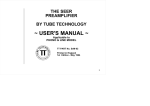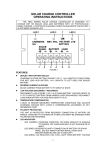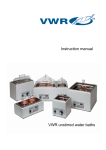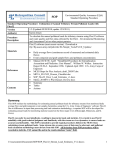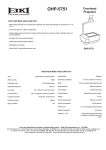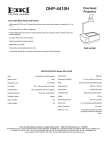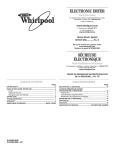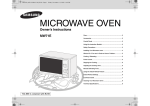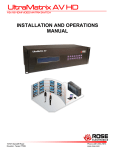Download Synergy DMA Manual
Transcript
SYNERGY DMA DUAL MONO POWER AMPLIFIER BY TUBE TECHNOLOGY ~ USER'S MANUAL ~ TT PART No. Sy2M-01 Printed in England 1st Edition - September 1995 i The Synergy Synergy -(defn); Simultaneous action of separate instances which, together have a greater total effect then the sum of their individual accomplishments. ii Introduction Thank you for selecting the Synergy Amplifier from Tube Technology. We hope The Synergy will bring you many years of pleasure as an important part of your hi-fi system. Please read through this manual so you will know how to operate your Synergy amplifier properly. After you have finished reading this manual, please put it away in a safe place for future reference. Please do not forget to complete and return the enclosed registration card. We wish you many hours of musical enjoyment ! iii Contents 1. 2. 3. 4. 5. 6. 7. 8. 9. 10. Getting Started Unpacking your Synergy Amplifier Checking and Installing the tubes Mains Connection Connecting the Synergy to the household mains supply Wiring a Mains Plug - UK Installation Installing & ventilation of your amplifier Audio Connection - Rear Panel Connecting the Synergy's Inputs Connecting your Synergy to the loudspeakers Operating your System - Front Panel Switching your amplifier On & Off Control & Front Panel Functions Operational Notes Running-In Burning in your Amplifier Tube Information Maintenance Care and Cleaning of your amplifier Adjusting Bias using the OBBC system Troubleshooting Specifications Guarantee Claims under the Guarantee Tube Renaissance 1 2-4 5 6 7 8 9-10 11 12-13 14 15 15 16 16-17 18 19 20-21 21-22 23-27 Contents - 1 Conventions This manual uses the following conventions; Bold indicates emphasis or a minor heading. Italic Bold refers to a sub heading of a chapter. This symbol refers to Notes containing important information set off from the text. THIS SYMBOL REFERS TO CAUTION MESSAGES AND PROCEDURES WHICH IF NOT OBSERVED CAN LEAD TO DAMAGE OR INJURY Contents - 2 Getting Started This chapter contains information on; Unpacking your Synergy Amplifier Checking & Installing the Vacuum Tubes Unpacking Your amplifier is packed in "jiffy-cell" support foam. Grip the top of this foam and simply pull it out of the box. The Synergy is then left sitting on its bottom support. Lift out carefully, remembering that the centre of gravity is biased towards the rear of the unit due to the heavy transformers.(It may be neccessary for another person to help manouvre the unit as it is very heavy) All packing should be retained. Amplifiers returned under guarantee are only accepted in their original packaging. The following items are included in the packaging of a Synergy No.1; 1 12 1 1 1 1 x x x x x x Synergy DMA Amplifier EL34 Output Vacuum Tubes Bias Adjust trimmer Reference Manual & Registration Card IEC Mains Lead Spare mains fuse (6.3A T) (8.0A T 100V/120V) Getting Started 1 Installing the Tubes The Synergy is usually shipped with its output tubes packed separately, this helps protect them during transit. If you have ordered a protection grille with your amplifier the output tubes have already been installed and there is no need to read this section. The input and driver tubes are already in place inside the amplifier, please do not remove these, as they have been calibrated. The vacant tube sockets on the amplifier are numbered 1 to 6, for the left hand channel of the amplifier and 7 to 12 for the right hand side. (See diagram 1) The output tubes which are packed separately locate in these sockets. The relevant tube number is printed on the inside flap of each box, or if you have a Gold Aero model, on the tube caps . Remove the tube carefully from its packing and install it in its matching socket, as labeled in Diagram 1. Ensure that the keyway on the base of the tube lines up with the keyway on the tube socket. Each tube must be inserted carefully. Align the tube pins in the centre of the receptacles on the tube base, then apply gentle downwards pressure, firmly pushing the tube home into its base. Do not rock the tube from side to side as the keyway on the tube base will fracture. Getting Started 2 Diagram 1 Master Bias Adjustment (Left Channel) Getting Started 3 Diagram 2 shows the arrow pointing to the positions of the keyways on the EL34 and the keyways on the amplifiers tube sockets. Tube Base Tube Socket Diagram 2 If the glass on any of the tubes is cracked or broken do not use, consult your dealer for a replacement and refer to the Maintenance chapter for instructions on how to replace a faulty tube. Remove the tubes from their cartons and fit - one at a time. This will ensure that each tube is in its correct socket as calibrated when leaving the factory. If you should mix up the order refer to replacing a tube in the maintenance chapter. Getting Started 4 Mains Connection This chapter contains information on; Connecting the Synergy to the household mains supply. Wiring a mains plug (UK) Mains Connection Your Synergy amplifier plugs into the mains supply via the IEC socket located on the back panel (see diagram 3). The amplifier has been factory set to the correct mains voltage for your country. The voltage setting is marked on the serial badge, located on the rear panel. (See diagram 3). Check that this voltage complies with your local supply. Also make sure that your mains outlet is able to deliver the required current for the equipment plugged into it. The wattage rating is also marked on the serial badge. DO NOT CONNECT/SWITCH-ON THE MAINS SUPPLY TO THE AMPLIFIER BEFORE COMPLETING ALL OTHER CONNECTIONS. IF YOU ARE IN ANY DOUBT REGARDING MAINS CONNECTIONS PLEASE DO NOT PROCEED ANY FURTHER WITHOUT CONSULTING YOUR DEALER. Mains Connection 5 Wiring a Mains Plug Export units for certain markets have a moulded mains plug fitted to comply with local standards. If your mains supply lead does not have a plug fitted, the coloured wires should be connected to the appropriate plug terminals in accordance with the following code. Wire Colour Label on Plug GREEN/YELLOW E or EARTH or BLUE N or NEUTRAL or BLACK BROWN L or LIVE or RED If your mains plug has a fuse, please fit a fuse with 13A rating. If your amplifier is not set correctly for the local supply or if you intend to move the amplifier to a location where the supply is at a different voltage, it will be necessary to change the voltage taps on the mains transformer. We recommend that this is done by an experienced technician. Refer to changing voltage in the maintenance chapter. DO NOT SWITCH ON THE AMPLIFIERS BEFORE COMPLETING THE AUDIO CONNECTIONS. Mains Connection 6 Installation This chapter contains information on; Installing and Ventilating your amplifiers Installing & Vetilation Ensure that the amplifier is placed in a stable location that is able to accept its weight each unit weighs 46 kilograms. It is not recommended that amplifiers are installed in cupboards or in any enclosed area if there is not sufficient air space and ventilation to keep them cool. A minimum distance of six inches above the amplifier should be allowed as this is where most of the heat is generated. Dedicated racks are available for housing your tube equipment, contact your dealer or Tube Technology. Do not locate the amplifier close to radiators or any other heat source, this could increase the operating temperature. Do not locate the amplifier too close to a turntable, as the cartridge could pick up hum from the power transformers. THE OUTPUT TUBES REACH VERY HIGH TEMPRATURES!! DO NOT TOUCH UNDER ANY CIRCUMSTANCES. FOR EXTRA PRECAUTIONS A TUBE PROTECTION GRILLE IS AVAILABLE. Installation 7 Audio Connection This chapter contains information on; Connecting the Synergy's Inputs & Output Connecting your Synergy to the loudspeakers. Rear Panel Information Connecting the Inputs & Output AUDIO INPUTS Your amplifier uses high quality connectors to ensure that maximum signal transfer is possible, therefore ensure that all cables used for connection to the amplifier are terminated with connectors of similar quality. These connectors for both left and right channels, connect to your preamplifier. These connectors are safety RCA jacks, which have a negative retractible spring, for the short circuit protection of any RCA plug. This allows you to plug and unplug your inter-connects without having to switch off the amplifier. Audio Connection 8 TUBE PROTECTION IEC INLET MAINS FUSE MAINS SWITCH Connection to Loudspeakers The Synergy incorporates a special resettable fuse for each of the twelve output tubes. This protects the amplifier from the potential damage that may be caused to the amplifier electronics if an output tube should go faulty. When activated the fuse stops the tube from drawing current, the bias meter will display -1. Please note the filament will still be glowing. The IEC connector on the rear panel, connects to the mains supply via the mains cable supplied. This fuse is rated at 6.3 A, and protects both the large dome shaped transformers. This switches the amplifier On & Off, it has a red indicator when in the On position. The loudspeaker outputs are suitable for driving loudspeakers with impedances in the range of 6-8 ohms. The output terminals are 4mm terminal posts and each will except two 4mm (banana) plugs or bare wire. For bi-wiring use the side entry holes together with the front entry holes. Connect the positive or (+) of the speaker cable to the red terminal on the amplifier, and the negative or (-) to the black terminal on the amplifier. DO NOT SWITCH-ON THE SYSTEM UNTIL YOU HAVE READ CHAPTER 5 Operating Your System. Audio Connection 9 Rear Panel Diagram 3 Audio Connection 10 Operating your System This chapter contains information on; Switching your amplifier ON and OFF. Control & Front Panel Functions Operational Notes Switching On & Off The main switch for switching the Synergy On & Off is located on the rear panel, (See diagram 3) it has a red indicator strip to indicate the On position. With this switch in The ON position, the unit can now be operated from the switch in the centre of the control panel. OPERATE indicates operation of the unit and STANDBY switches the amplifier Off. Front Panel Diagram 4 Operating your System 11 After switch on there is a delay of approx. 15 seconds before the main HT is switched, each channel is switched On separately, an audible thump is heard from the mains transformer on each channel as they power up, this is due to pole reversal which is quite normal for large power transformers. The indicators on the front panel change from Amber to Green as each channel is powered up. Front Panel Functions Left & Right Status Indicators These LED's are bi-colour and are illuminated in either two colours. GREEN indicates that the unit is switched on and functional, AMBER indicates that the unit is in Standby. Operating your System 12 Diagram 5 Control Panel Operating your System 13 Operational Notes Some users of tube amplifiers believe that because tube amplifiers take some time to warm up that they should be left on all the time. The Synergy amplifier reaches peak performance levels 15-20 minutes after switch on. Unless absolutely necessary it is not recommended that you leave your amplifier permanently switched on, this only wastes electricity and tube life, but if necessary the Synergy is quite capable of being left switched on for very long periods of time. THE OUTPUT TUBES REACH VERY HIGH TEMPERATURES!! DO NOT TOUCH UNDER ANY CIRCUMSTANCES. FOR EXTRA PRECAUTIONS A TUBE PROTECTION GRILLE IS AVAILABLE. The glass envelope surrounding the tube can reach temperatures of up to 300 degrees centigrade. A tube is a perfectly safe device if not touched when it is operating, rather like a hot light bulb. For owners of pets and young children we recommend a Tube Technology tube protection grille. It is quite normal for the amplifiers to produce a very small amount of mechanical hum when they are in operation.. This is due to the large power transformers. DO NOT REPEATEDLY SWITCH THE AMPLIFIER ON AND OFF. ONCE YOU HAVE SWITCHED THE AMPLIFIER OFF, WAIT APPROX. 15 SECONDS BEFORE SWITCHING IT ON AGAIN. Operating your System 14 Running-In This chapter contains information on; Burning-In your Amplifier Tube Information Burning-In Amplifiers "Burning-In" is a generic term given to the basic 'running-in' of the amplifier. You may notice a slight 'electronic-smell' from your amplifier during the first few days of operation. This smell is usually caused by various prints and dyes used on the components which takes some time to evaporate This is quite normal and there is no need for concern as your amplifier has been extensively soak tested before leaving the factory. This burning-in process continues with your use of the amplifier. This process simply allows for new components like tubes, capacitors and resistors to settle and 'sweeten' enhancing the amplifiers sonic performance. An estimated 80 hours of operation allows your Synergy amplifier this running-in period. Tube Information Unlike most other amplifiers, we run our tubes with very little standing current, this conservative use of the tube provides an extended reliable tube life. As with all tubes, their qualities degrade with age due to cathode emission (a natural process common to all tubes) A typical life span of an EL34 output tube in a Synergy would be approx. 4000 hours, after which time they should be replaced, thus keeping your amplifier at it's maximum sonic performance; Refer to the Maintenance chapter. Running-In 15 Maintenance This chapter contains information on; Care and Cleaning of your amplifier Bias Measurements of the Output Tubes Troubleshooting Changing Mains Voltage Care & Cleaning OBBC Bias Measurement All polished metal parts on your amplifier are unlacquered. These metal parts will in time lack lustre due to oxidisation. They can easily be restored to original condition by using a mild metal polish (such as duraglit) and a soft polishing cloth. Do not clean the units with water as this smears the surface and can leave water marks. When dusting the amplifiers be sure not to catch the tubes as this may crack the glass. Alternatively you can remove the tubes (remembering the order they were removed in) and clean the amplifier. Anodised parts such as the front panel and control panel & painted parts such as the bottom cover are best cleaned with a damp cloth then buffed with a dry cloth. The Synergy amplifier uses a fixed bias system that requires very little attention. It is necessary to re-adjust the bias if you fit a new tube to the amplifier, or if the order of the tubes shipped with the amplifier has been mixed up. The Synergy uses an On Board Bias Control (OBBC) to adjust the amount of bias on each tube. This metering system is located behind the removable door in the middle of the control panel. On lifting this door the amplifier automatically switches into mute, this is neccessary to adjust the bias. Follow the procedure in table 1 to adjust the bias. Maintenance 16 Step Table 1 Action Remark 1. Remove the door in the centre of the control panel, to reveal the meter. Identify the 12 bias potentiometers, located in the lower section of the cutout. Gold screw heads are visible, through round holes. 1-6 are for the left hand channel and 7-12 for the right hand channel. 2. Rotate the black knob in the centre of the meter to the relevant tube number. (see diagram 1 for tube numbers) The Liquid Crystal Display will now give a reading of this particular tube. 3. With the trimming tool provided adjust the bias potentiometer gold screw head until the meter gives a readout of 35.0. This action should be carried out after the amplifier has warmed up for at least 5 minutes. 4. If you are unable to bias a tube to 35 it is possible to adjust the master bias for extra voltage range. (see diagram 1) This adjustment is very critical and only needs a small turn for a large change in reading. UNDER NO CIRCUMSTANCES SHOULD AN UNQUALIFIED PERSON REMOVE THE COVERS OF AN AMPLIFIER. Maintenance 17 Troubleshooting SYMPTOM REMEDY Amplifier switches on but there is no sound from the system. 1. Check you have connected the source you are trying to play ie. cd player to the relavant RCA input connector on amplifier 2. Check that the loudspeaker connections have been made. 3.Ensure the amplifier has its OBBC lid on, and it is not in mute. Amplifier does not switch on 1. Ensure IEC plug on mains lead is a snug fit. 2. Check the mains fuse located on the rear panel see diagram 3. Tubes Pulsate and glow blue 2. Ensure you have not switched the amplifier On & Off without waiting at least 30 secs. A tube or tubes glow very bright cherry red, shortly after switch on. (Do not confuse with normal filament glow) 1. Turn amplifier off imediately. 2. Tube is faulty, check this tube with the OBBC 1. The tube you have replaced is ' microphonic '. This is particularly noticeable if the tube has been 2. Change the tube for another. Maintenance 19 Specifications Figures given below are for a typical Synergy Power Amplifier Vacuum Tubes EL34/6CA7 x 12 ECC81/12AT7 x 4 (Driver Stage) Output Power 150 watts + 150 watts (8 ohms) Frequency Response LINE - 5Hz - 120 KHz @ 1W +/- 1dB 10Hz - 50KHz @ 150W +/- 1dB Input Sensitivity LINE - 775 mV (output 150W RMS ) Input Impedance LINE - 130 KOhms Output Load Impedance 6 - 8 Ohms (2 ohms switchable optional) Power Consumption Quiescent = 250W, Full power = 650W Voltage 110V, 120V, 220V, 230V, 240VAC Dimensions 470 (W) x 470 (D) x 150 (H) mm Weight 45 Kilograms Specifications 19 Guarantee This chapter contains information on; The Guarantee of your Synergy amplifier Tube Guarantee Registration Claims under this Guarantee Guarantee This equipment has been fully tested and a full record of these tests made before despatch from the factory. Both the workmanship and the performance of this equipment are guaranteed against defects for a period of TEN YEARS from the date of purchase, provided that it was originally purchased from an authorised dealer under a consumer sale agreement, at or near the recommended retail price. (The words "consumer sale" shall be construed in accordance with section 15 of the Supply of Goods (Implied Terms) act 1973). This guarantee covers both labour and parts and is transferable to subsequent purchasers but the liability of the manufacturers is limited to the cost of repair or replacement (at the discretion of the manufacturers) of the defective parts and under no circumstances extends to consequential loss, damage or shipping charges. Guarantee 20 The manufacturers can accept no responsibility for defects arising from accident, misuse, wear and tear, neglect or through unauthorised adjustments and or repair, neither can they accept responsibility for damage or loss occurring during transit to or from the person claiming under this guarantee. Tube Guarantee This equipment has a SIX MONTH guarantee on the tubes allowing for any manufacturing defects to arise. If a tube is found to be defective it should be returned to the dealer or failing this, directly to Tube Technology packed in its original packaging. Registration Please complete the registration card and return it to Tube Technology. Your guarantee is invalid without registration. To transfer this guarantee to subsequent purchasers, the new owner must notify Tube Technology of their name, address and serial numbers of the equipment. Claims under this Guarantee This equipment should be packaged in the original packaging and returned to the dealer from whom it was purchased or, failing this, any other authorised Tube Technology dealer. If it is not possible to return the equipment by hand then it should be sent carriage prepaid by a reputable carrier. Should the original packaging not be available replacement packaging can be purchased from the manufacturers. The equipment should not be sent by post. DO NOT CONSIGN THE EQUIPMENT TO TUBE TECHNOLOGY UNLESS YOU HAVE FIRST BEEN SPECIFICALLY REQUESTED TO DO SO BY THE MANUFACTURERS TECHNICAL SERVICE DEPARTMENT. DO NOT UNDER ANY CIRCUMSTANCES ATTEMPT TO DISASSEMBLE THE EQUIPMENT BEFORE DESPATCH. Guarantee 21 If you have any difficulty complying with these requirements, please contact the manufacturers at the following address: TUBE TECHNOLOGY TECHNOLOGY HOUSE 214 STATION ROAD ADDLESTONE SURREY KT15 2PH ENGLAND Tel: (44) 01932 821111 Fax: (44) 01932 821182 In either case you should state clearly your name and address, the date and place of purchase together with a brief description of the fault experienced. In the event of equipment being returned which on test is found to comply with the published specifications the manufacturers reserve the right to charge a reasonable fee for testing the equipment and for return carriage. The manufacturers are happy to answer any queries you may have regarding the use of this equipment on the condition that this enquiry is by letter. You should state clearly the serial number of the unit, the dealer from whom it was purchased and the date of purchase. THIS GUARANTEE IN NO WAY VARIES OR REMOVES A PURCHASERS STATUTORY RIGHTS. Guarantee 22 Tube Renaissance Tube Renaissance A possible expalnation of why tubes may sound better than transistors. From the late 1960’s, tubes were largely, though not entirely, superceded by semiconductors in audio frequency amplifier designs. This was an inevitable consequence of a continuing quest for new techniques. Semiconductors (Transistors and Integrated Circuits) have certain and obvious advantages: their small size, absence of heaters, low voltage operation and consequent opportunity to dispense with output transformers may appear to make tubes obsolete. However, from about 1975 onward, there has been a resurgence of interest in tubes; and it seems worthwhile to consider why. It is said by ‘hi-fi’ enthusiasts that tube amplifiers sound better, that their distortion is either lower or less noticable. Carefully conducted listening tests seem to bear this out, although their results are difficult to interpret. If there really are subjective differences to a listener between tubes and semiconductor amplifiers, can they be explained technically? One thing should be clearly understood: it is possible to design either a tube or a semiconductor amplifier so that over a certain range of output power its distortion will be so small as to be imperceptable to the ear. Therefore, if two similarly rated well-designed high fidelity amplifiers, one using tubes and the other using semiconductors, are compared in the same listening conditions, correctly operated, their performance should be indistinguishable - and subjectively perfect. Now, on the basis of measured performance, many modern high fidelity semiconductor amplifiers are actually superior to the older tube amplifiers, which were already good enough for their distortion tobe imperceptable; so how can here be subjective differences? It seems that there cannot be any, while the amplifiers are correctly operated: and this may be the key to the mystery, for there are two major problems: one is that it is extremely difficult to avoid occasional over driving of an amplifer, because of the very Tube Renaissance 23 large dynamic range of the audio signal; and the other is that the loading is not always resistive. It is under these (usually unintentional) wrong conditions that differences may show up. sound level. One has no way in advance of knowing in advance whether there is an exceptionally loud passage coming that will over drive the amplifier. Bursts in excess of 30dB above the average are quite rare. Let us consider the over driving first. Owing to continual improvements in recording and playback technique, the possible dynamic range of music signals- from either disc or tape - is greater now than it used to be. As a tentative estimate, it appears that the loadest passage of a modern disc recording maybe 40dB above the average sound level. Now it may be said that amplifiers in a high fidelity system ought theoretically to be able to reproduce the loudest of loud bursts without distortion. However, to allow for 40dB above 50mW - not a very high listening level - a power capability of 500W would be required; and further developments may make the figure even greater. One seems to hear a cry of “where is it all going to end?” Anyway, when setting up an amplifier system one adjusts the gain to give the prefered average If we accept, then, that occasional over driving is virtually inevitable, how will the amplifier behave? We now come to the first possible reasons why tubes and semiconductors may “sound different”. Presented with an over large signal, tubes merely clip the peaks, delivering a flat-topped waveform while the over driving is taking place. The limiting may occur at the grid as the circuit resistances are commonly such as to prevent it from being driven more than slightly positive, or it may be the results of coalescence of characteristic curves at lower voltages. The ear is surprisingly tolerant of such clipping when it occurs only on these occasional load bursts. The semiconductors used in audio amplifiers are virtually always bipolar transistors, either discrete or integrated. They require base Tube Renaissance 24 current to be applied in order to make collector current flow. Now transistor amplifiers normally incorporate a large amount of negative feedback, and, when such an amplifier limits, some of its stages are driven very hard, so that extra large base currents are drawn. If any capacitors are affected by such current pulses, the result may well be that a brief over driving is followed by a comparatively long recovery signal, which would be much more noticeable than mere clipping of peaks. Even with dc coupling, there may still be capacitors that can cause such extra signals. There is a further effect that takes place in the transistor itself, because of the phenomenon of charge storage. A transistor that has been conducting does not switch off immediately when the forward base bias is removed, but continues to take collector current until all the relevant charge carriers that are in transit have been swept out. The effect is most pronounced in a transistor that has been turned on hard: in fact the larger the base current the longer will be the turn-off time. In audio transistors that have been over driven this time may be of the order of hundreds of microseconds, so this effect can also give rise to spurious signals. When it is realised that even the most critical listener cannot detect peak clipping of occasional short loud bursts by as much as 6dB, we can understand why it is sometimes said that a 50W tube amplifier can sound equal to some 200W transistor amplifiers. A tube amplifier can be quite grossly over driven with little or no subjective effect on sound quality, whereas most transistor amplifiers probably cannot. The other kind of unintentional wrong operation we have to consider is incorrect oading. The impedance of a loudspeaker system is by no means constant: a so-called 8 ohm system may well present anything from 4 to 16 ohms over the audio frequency range, and be highly reactive at some frequencies. It is under reactive load conditions with large signals that another major difference appears between tubes and transistors. The combina- Tube Renaissance 25 tion of simultaneous high voltage drop and high current occurring for brief periods at certain parts of the elliptical load line does not normally affect tubes, may cause a catastrophic second breakdown effect, in which a permanent short circuit develops - not to be confused with ordinary avalanche break down, which is a reversible phenomenon. The risk of second break down may be avoided by using transistors with sufficiently high ratings to be well clear of the effect, if available; but the alternative commonly employed is to incorporate protective circuitry that cuts the signal whenever the output transistors are subject to a dangerous combination of voltage and current, and this obviously has a very unpleasant effect on the sound. The purpose of these remarks is not to denigrate transistor amplifiers, but to present a case for tubes, and to show that there may be technical reasons for the supposedly subjective effects that have been attributed to transistors. Ways may be found of eliminating or obviating these effects in a transistor amplifier design; but there is a simplicity about tube circuitry which may appeal to many audio engineers, both professional and amateur. A further point can be made in favour of tubes, concerning cooling. Output transistors have to be conduction cooled, preferably by some method that does not heat up other semiconductors in the circuit. This requires some rather bulky metalwork thermally isolated from the rest of the chassis. Glass envelope tubes, on the other hand, looses most of their heat by a mixture of convection and radiation. A brief reference may be in order here about what is usually considered to be main disadvantage of a tube amplifier, the output transformer. It is indeed a heavy and costly item, to be set against the relative simplicity of circuit and various other advantages that have here been attributed to the tube equipment. However it can enable the amplifier to work into more than one load impedance, whilst a transformerless Tube Renaissance 26 semiconductor amplifier designed to drive an 8 ohm load would usually deliver only half its normal power into a 16 ohms, and might be damaged if operated with 4 ohms. Also, with an output transformer provided that it is correctly loaded, the amplifier input sensitivity without feedback is the same whatever the value of load impedance; and by taking the negative feedback connection from a fixed point on the secondary winding the sensitivity with feedback can be made similarly independent of load impedance: in other words, the number of decibels of feedback and therefore the reduction of distortion, damping factor and so on, are the same whatever the load. So there is something to be said for having an output transformer. practise; and not only the output stage, but also low level stages are involved in these. Tubes have a distict advantage in operation with reactive loads, and are easier to cool. Even the need for an output transformer is not quite such an unmitigated drawback as it may sometimes seem. These may be some of the reasons why a substantial part of the audio amplifier market has stayed with tubes during the “transistor era”, and why there has recently been such a remarkable “Tube Renaissance”. Perhaps enough has been said to suggest at least that the advantages are not entirely on the side of semiconductors, and that points can be made in favour of tubes, concerning both performance and convenience in use. Semiconductors may produce un-welcome effects on over driving, so difficult to avoid in Tube Renaissance 27


































